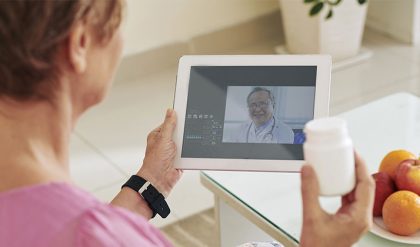It’s exciting to see how far telehealth has come. Virtual care has advanced from a curious form of clinical communication to a mainstay in the way providers and consumers interact. From being a side feature of the healthcare system to an expectation.
While there’s no common definition of telehealth (and its many synonyms), the term itself can evoke a limited view of what telehealth does. What was, until recently, referred to as telemedicine now encompasses a much broader array of services and technologies – AI, virtual reality and behavioral economics are a few examples that come to mind – that are transforming the way health and care are delivered. ATA promotes the representation of this broader telehealth universe in our membership and initiatives.
Telehealth Benefits
Improved Access – Since its inception, telehealth has been used to bring healthcare services to consumers in distant locations. Telehealth not only improves consumer access, it extends the geographic reach and expertise of physicians and health facilities. Given provider shortages around the world, telehealth has a unique and appealing value proposition. It can provide millions of people in both rural and urban areas access to safe, effective and appropriate care when and where they need it.
Cost Efficiencies – Reducing or containing the cost of healthcare is one of the strongest motivators to fund and adopt virtual care technologies. Telehealth reduces the cost of healthcare and increases efficiency with better management of chronic diseases, shared health professional staffing, reduced travel times, and fewer or shorter hospital stays.
Improved Quality – Studies have consistently shown that the quality of healthcare services delivered via telehealth are as good as those given in traditional in-person consultations. In some specialties, particularly in mental health and ICU care, telehealth delivers a superior product, with greater outcomes and consumer satisfaction.
Consumer Demand – The greatest impact of telehealth is on the consumer, their family and their community. Using telehealth technologies reduces travel time and related stresses for the consumer. Over the past 15 years, multiple studies have documented consumer satisfaction and support for telehealth services. Such services offer consumers the access to providers that might not be available otherwise, as well as medical services without the need to travel long distances.
Services Provided by Telehealth
Sometimes tele is best understood in terms of the services provided and the mechanisms used to provide those services. Here are some examples:
Live videoconferencing (synchronous) – the delivery of a live, interactive consultation between Primary care and specialist health services. This may involve a primary care or allied health professional providing a consultation with a patient, or a specialist assisting the primary care physician in rendering a diagnosis.
Store and forward (asynchronous) – the use of store and forward transmission of diagnostic images, vital signs and/or video clips along with patient data for later review that enables a primary care or allied health professional providing a consultation the ability to render a diagnosis.
Remote patient monitoring (RPM) – including home telehealth, uses devices to remotely collect and send data to a home health agency or a remote diagnostic testing facility (RDTF) for interpretation. Such applications might include a specific vital sign, such as blood glucose or heart ECG or a variety of indicators for homebound consumers. Such services can be used to supplement the use of visiting nurses.
Mobile health (mHealth) – Consumer medical and health information includes the use of the internet and wireless devices for consumers to obtain specialized health information and online discussion groups to provide peer-to-peer support.
Delivery Mechanisms
Networked programs link tertiary care hospitals and clinics with outlying clinics and community health centers in rural or suburban areas. The links may use dedicated high-speed lines or the Internet for telecommunication links between sites. ATA estimates the number of existing telehealth networks in the United States at roughly 200 providing connectivity to over 3,000 sites.
Point-to-point connections using private high-speed networks are used by hospitals and clinics that deliver services directly or outsource specialty services to independent medical service providers. Such outsourced services include radiology, stroke assessment, mental health, and intensive care services.
Monitoring center links are used for cardiac, pulmonary or fetal monitoring, home care and related services that provide care to patients in the home. Often normal land-line or wireless connections are used to communicate directly between the patient and the center although some systems use the Internet.
Web-based e-health consumer service sites provide direct consumer outreach and services over the Internet. Under telehealth, these include those sites that provide direct consumer care.
Common Questions Answered
What is telehealth?
Technology-enabled health and care management and delivery systems that extend capacity and access.
How common is telehealth?
Telehealth is health. It is a significant and rapidly growing modality of care in the United States and utilization rates are rising. According to a 2018 JAMA study, annual telemedicine visits have increased at an average annual compound growth rate of 52% from 2005 to 2014. The AHA states that 76% of U.S. hospitals connect with patients and consulting practitioners using video and other technology, and a study performed by NGBH revealed that virtually all (96%) of the nation’s large employers will provide medical coverage for telehealth in 2019.
Is telehealth safe?
Yes. Data from a 2018 survey of healthcare providers by Deloitte found that telehealth can improve patient experience, an important factor in quality care. In fact, nine out of ten physicians (90%) see the benefits of virtual care, especially regarding patient experience – access to care, patient satisfaction, and improved communication with the care team being the main benefits.
What is the market size for telehealth?
While market size estimates vary depending on units of service, all research firms agree the telehealth market is growing rapidly. One analyst report found the global telemedicine market is expected to grow at a compound annual growth rate (CAGR) of 16.8% from 2017 to 2023.
Does Medicare or Medicaid pay for telehealth services?
Medicare – Yes, in certain circumstances. Many telehealth services, such as remote radiology, pathology and some cardiology, are covered simply as “physician services.” For traditional fee-for-service beneficiaries living in rural areas, Medicare covers physician services using videoconferencing and remote patient monitoring. The 14 million beneficiaries in Medicare Advantage (managed care) plans may have broader access, depending on their plan benefits. The ATA is committed to removing arbitrary restrictions that limit telehealth coverage.
Medicaid – Every state Medicaid plan covers at least some telehealth services; however, states vary greatly in their coverage. The ATA has challenged each state to fully cover telehealth to improve access while simultaneously reducing service costs.
Do private insurance plans usually cover telehealth services?
Thirty-two states and the District of Columbia have parity laws that require private insurers to cover telehealth the same as in-person services. Most insurance providers cover at least some telehealth services.


